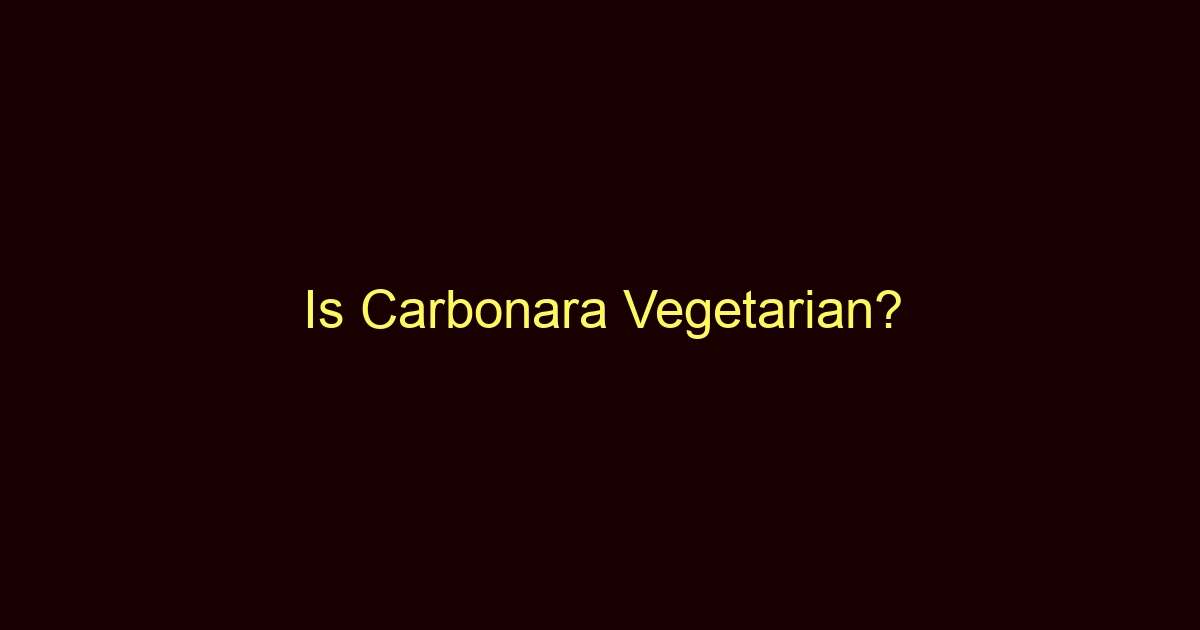Is carbonara vegetarian? No, traditional carbonara is not vegetarian. It typically includes pork, such as guanciale or pancetta, and is made with a sauce of eggs and hard Italian cheese, making it unsuitable for a vegetarian diet.
Wondering if that creamy, decadent bowl of carbonara is vegetarian-friendly? In its traditional form, the answer is a straightforward no. Carbonara usually includes ingredients like pork and eggs, making it a no-go for vegetarians. Read on to understand the intricacies of what goes into making this popular Italian dish and how to modify it for a vegetarian lifestyle.
How Carbonara Is Made?
When you bite into a bowl of authentic carbonara, what are you really tasting? For a dish that seems relatively simple often made with just a handful of ingredients the complexity of its flavors is remarkable. At its core, traditional carbonara consists of pasta, usually spaghetti, combined with sautéed pork, often guanciale or pancetta.
Once the pasta is cooked al dente, it’s mixed with the pork and then incorporated with a sauce made from beaten eggs and grated Italian hard cheese, such as Parmesan or Pecorino Romano. Ah, but there’s a trick! The hot pasta cooks the eggs just enough to create a creamy, almost ethereal sauce without scrambling them.
What might surprise some is the lack of any dairy products like cream or butter in authentic carbonara recipes. Unlike some modern versions you might find outside of Italy, a true carbonara relies on the magic chemistry between eggs and cheese to achieve its iconic creaminess. The result is a dish that is rich, flavorful, and satisfying, yet not overly heavy. It’s comfort food at its most sophisticated.
As for the pork component, traditionally guanciale, which is cured pork jowl, or pancetta is used. These meats are sautéed in olive oil until crispy. High-quality ingredients are essential here every component brings something indispensable to the final dish.
Carbonara has variants that include additional ingredients like peas, mushrooms, or other vegetables, especially outside of Italy. However, these are not part of the classic recipe. In summary, making carbonara is an art that respects tradition, and its basic recipe calls for specific ingredients that give it its unique, memorable flavor.
Why Carbonara is Not Vegetarian?
Carbonara, in its authentic form, is not vegetarian because it includes meat, typically in the form of pork like guanciale or pancetta. In addition to that, it uses eggs and often hard cheese made from animal rennet, which some vegetarians avoid.
So, there’s a triple whammy for vegetarians: meat, eggs, and potentially non-vegetarian cheese. Even without considering the variants that may include additional animal products, traditional carbonara is squarely in the non-vegetarian category.
But why is the meat so critical in carbonara? In essence, the pork used in the dish provides a deep, salty flavor that contrasts beautifully with the creamy egg-based sauce. It’s not merely about adding some protein; the type of meat and its preparation are integral to the dish’s overall flavor profile. The sautéed pork also adds texture, giving a crispy bite that complements the soft, coated pasta.
Furthermore, the eggs and cheese in carbonara aren’t just filler; they’re essential ingredients that give the sauce its creamy consistency and nuanced flavor. These elements are sourced from animals, making them off-limits for vegetarians who abstain from consuming animal products for ethical or dietary reasons. While some might argue that you can substitute these elements, doing so fundamentally changes the dish.
How to Make Vegetarian Carbonara?
Good news for vegetarians: making a meatless version of carbonara is not only possible, but it can also be delicious. Start by choosing a plant-based alternative to pork. Tempeh or smoked tofu can work wonders in mimicking the texture and providing the needed protein. For the sauce, you can stick to the traditional egg and cheese combination, or use a dairy-free cheese if you’re leaning vegan. Some people also add a splash of plant-based milk to get that creamy consistency.
Cook your pasta al dente and sauté your plant-based “meat” in olive oil. Then, proceed to mix these with your chosen sauce ingredients. The hot pasta will help thicken the sauce, just like in the traditional version. While this may not be carbonara in the strictest sense, it’s a dish that captures the spirit of the original, making it possible for vegetarians to enjoy this Italian classic.
Final Thoughts
So, there you have it. Traditional carbonara is a delightful blend of high-quality pasta, specific cuts of pork, and a creamy sauce made from eggs and hard Italian cheese. Its signature taste and texture come from a carefully chosen list of ingredients that, unfortunately for vegetarians, includes non-vegetarian items.
However, the culinary world is always evolving, and it’s entirely possible to make a delicious vegetarian version of carbonara. With the right substitutes like plant-based meats and potentially dairy-free cheese, you can come close to mimicking the traditional flavors and textures of this beloved dish.
In conclusion, while traditional carbonara might be off-limits for vegetarians, a few clever tweaks can make it accessible and equally delicious for those following a plant-based diet. It might not be carbonara in the eyes of an Italian grandmother, but it’s a dish that pays homage to the classic while being inclusive. And isn’t inclusivity what good food is all about?

